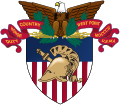This article needs additional citations for verification .(May 2015) |
| Cadet Monument | |
|---|---|
| United States | |
 Cadet monument in the old section of the West Point Cemetery | |
 | |
| For Cadet Vincent M. Lowe | |
| Unveiled | 1818 |
| Location | 41°24′0.2946″N73°57′56.5092″W / 41.400081833°N 73.965697000°W near |
The Cadet Monument is a monument at the United States Military Academy Cemetery, originally dedicated in honor of cadet Vincent M. Lowe, who died as a result of a premature cannon discharge in 1817. The names of cadets and professors who died while at the academy during its earliest days are inscribed upon the monument. [1] The monument is located in the far northeastern corner of the cemetery. [2]
